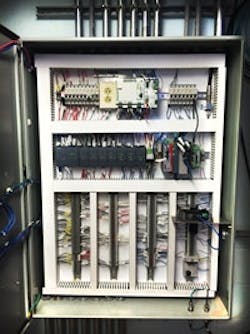Remote Retrofit
Many cities have water and wastewater treatment facilities that are aging and inefficient. Fair Oaks Ranch, Texas, was among those with antiquated water and wastewater infrastructure; its equipment was aging and nearly obsolete.
The age of the equipment made it difficult to find replacement parts and proper technical support. Beyond supportability of the equipment, the problems and inefficiencies of the old infrastructure were costing the city in numerous ways. The existing system used a combination of buried wires and leased phone lines to start and stop well pumps. The buried lines occasionally were damaged, and the leased phone lines were an expensive recurring cost and sporadically would be disabled by the phone company. There was no remote monitoring of wells, requiring city workers to drive around the city to verify operational status. The parts of the system that had radios were prone to loss of communication for extended periods of time.
The age of the system was not the only problem; the original controls system was locked down in a lot of ways, limiting flexibility for adjustments and improvements. Fair Oaks Ranch did not have program files for the older programmable logic controllers (PLCs), and many of the set-points were hard coded. Data collection also was inefficient; city workers had the time-consuming task of logging hand-collected data to the department’s database for report generation.
A Wireless Remedy
The city approached Siemens Industry’s Infrastructure & Cities Sector for its technology portfolio and consulting to assist in planning the city’s modernization and improvement project. The project was funded through Siemens Performance-based Contract Program. Siemens Performance-based Contracts allow municipalities to pay for their capital and energy improvements through their guaranteed energy, labor and cost savings. Siemens calculated a 14-year payback period with energy, labor and cost savings.
Patti Eng., a Control System Integrators Assn. (CSIA) member, is a CSIA-certified integrator and a Siemens Solution Partner. Siemens selected Patti Eng. to design and implement an infrastructure improvement solution for the project. With Siemens’ scope instructions, Patti Eng. was responsible for hardware design, software design and development, installation, commissioning and testing of the new system.
The solution was multifaceted. The design and implementation of a new SCADA system at all plants to allow for central control and management of equipment was a high priority. The lift stations and wells that previously had to be manually checked were outfitted with radio systems to allow for remote monitoring and control.
At the four water plants in the city, the existing control cabinets were retrofitted with the latest generation of Siemens PLCs, human-machine interfaces and uninterruptable power supplies. Radios were added at the water plants to communicate with the new radio modules at the city’s 28 wells to control the pumps and monitor whether they were operating properly.
A new control cabinet, similar to the updated ones at the water plants, was added to the city’s wastewater treatment plant for monitoring data points. Radios for communicating with the new radio modules at the seven lift stations also were added at this plant to monitor water levels and pump operations.
Lastly, 4G cellular routers and firewall/VPN appliances were installed at the four water plants and the wastewater treatment plant. These allow for remote real-time monitoring of each plant. In addition, alarm e-mails can be sent from each SCADA server.
Realizing Benefits
Previously, the city of Fair Oaks Ranch did not have remote monitoring and control options. Now, the city’s 28 wells, seven lift stations and eight storage tanks wirelessly communicate information and alarms directly through the new SCADA system to provide pertinent valve position, tank level, pressure and pump information on desktop and mobile devices in real time.
With the new radio modules, the city can start and stop well pumps remotely, and the operator receives feedback when the pumps are operating, which helps with operational efficiency analysis. If there is an issue with a well, operators receive an alarm remotely, and the process of identifying and remedying that issue is much faster than having to drive around town to manually verify operational status. Operators have much quicker access to well data to discover potential issues and make informed and quick decisions that can be implemented remotely.
Reports that were once made with hand-collected data now are automated, providing more timely and accurate intelligence. Operators can go back and review past alarm levels, pressure, etc. In addition, the untimely loss of radio communications that existed prior to the project no longer is a concern.
In contrast to the original locked-down control system, the new control system is fully supportable and flexible. It is customized to the needs of Fair Oaks Ranch; its programming software is documented and allows for access to project files. Set-points are adjustable from SCADA screens, and data points that previously had to be manually logged now are tracked by the software in the database, which produces reports automatically.
“The SCADA system will help the city of Fair Oaks Ranch save energy and operational costs associated with [its] water and wastewater infrastructure and backup power needs,” said Chad Nobles, executive accounts, EES for Siemens Industry’s Infrastructure & Cities Sector. “Patti Eng.’s ability to create a flexible and cost-effective solution met our standards and criteria, as well as our customer’s.”
For the next phase of the project, Siemens will replace aging and inefficient water meters with automated meter reading technology. The new automatic water meters will wirelessly transmit consumption data and allow the city to account for every customer’s daily usage, eliminating human error. The new meters will be more accurate and streamline reading routines—freeing staff resources and reducing expenses associated with the manual reading of the city’s old meters.
Download: Here
